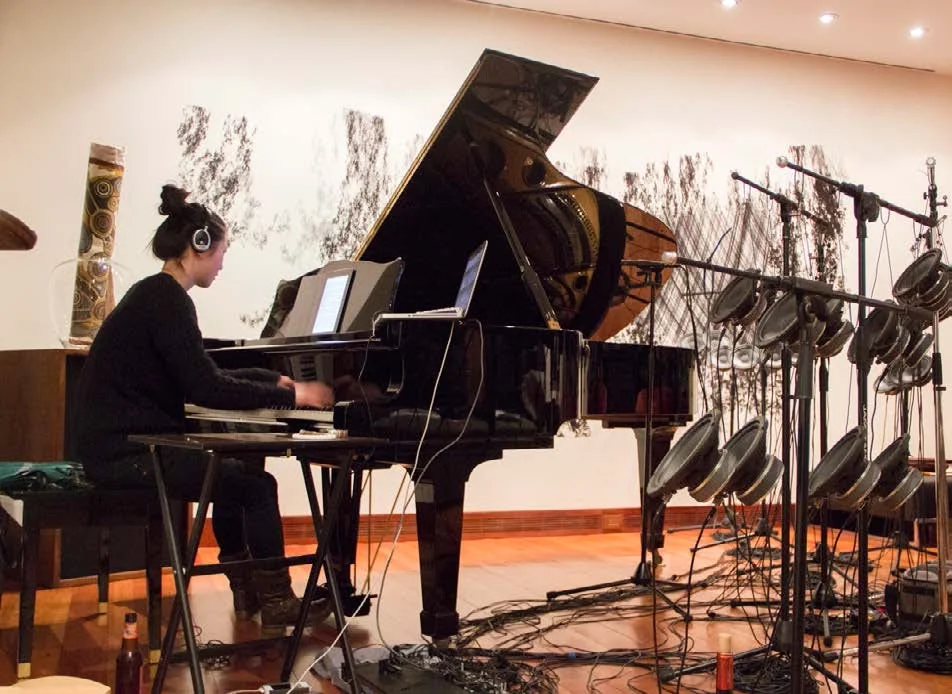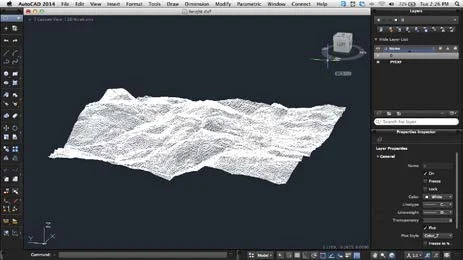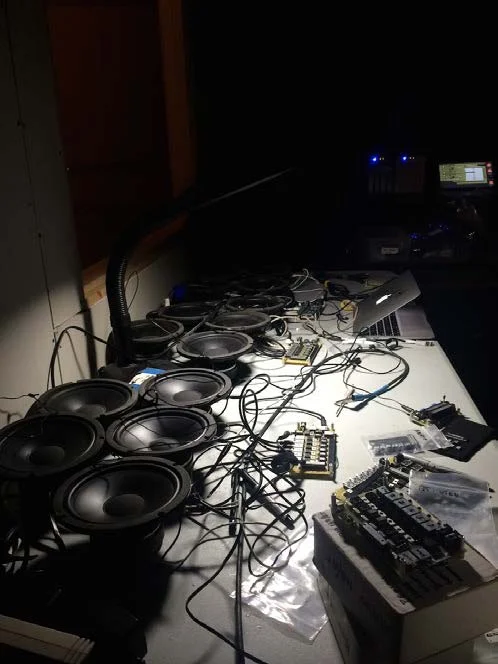
Vicky Chow Rehearsing Surface Image. Courtesy Tristan Perich.

Working with the Mesh for the CD Graphic Design. Courtesy Tristan Perich.

Building Electronics in the Studio. Courtesy Tristan Perich.
[](#)[](#)
Surface Image
Play It as It Lays
Tristan Perich is a New York City-based composer and sound artist whose accolades volley between a commission for Bang on a Can Festival held at Lincoln Center, an Artist-in-Residence at MIT, and the occupation of a patch of real estate at the MoMA in New York City at the tail end of 2013. Vicky Chow—who started playing her instrument of choice at age five—is a Canadian-born prodigy who matured into an established pianist and performer, earning praises from _The New York Times_ and _The Los Angeles Times_. At some point—they’re not sure when, and the memory is recounted a bit hazily—these two combined: pairing solo piano with one-bit electronic music. Perich took the reigns as the composer behind their latest production, _Surface Image_ (Perich describes the project as “Epic from the first conception”), while Chow occupies the piano bench. _Surface Image_ transforms traditional musical compositions by drawing from systematic conceptions of math and physics, and it seems Chow’s skill influenced this undertaking: Perich says, “It really needed to be a big feat. First because, well, I’m a pianist, but I hadn’t written any piano music for six years \[and\] when you think about writing a piece for Vicky, it needs to be a big piece—so it grew very quickly into a big piece.”
The result is an aesthetically dizzying synergy of acoustic strains and synthetic sounds. Audiences in New York got a first listen of the album at the MoMA PS1 on October 19 as it was performed live by Chow and meticulously fed out to attendees through 40 speakers surrounding the stage. But for now they’re content to take it slightly easier, collaborating on this interview, explaining the sum of all frequencies.
#### _Can you explain the meaning of Surface Image? How did you come up with that title?_
Tristan Perich: The title for me has something to do with how the sound shifts in the air maybe, or how sound radiates out from a source. And the sound is this surface, in a way, this continuous surface coming out from the instruments or speaker, or whatever is making that sound, and you interact with it through the surface of reality. I had this idea that this whole thing was also an image. So it’s like this combination of this image, sound, through the surface—if that makes any sense.
#### _What do you hope to get out of people when they listen to_ Surface Image_?_
Vicky Chow: When I’m playing it, I feel a lot of joy. And I’m hoping the audience will feel that fulfillment.
TP: I don’t feel like I have any particular agenda in this piece. There are a lot of ideas that make their way into my work in various ways. But at the end of the day it’s just music. It’s just appreciated and internalized in musical terms. That’s interesting of Vicky to feel jubilance for something like this. It’s kind of exciting in this piece for me, I hope that gets transmitted. In fact, it’s a more emotional and dramatic piece than a lot of mine. Maybe that’s also because it’s piano, and I feel like my whole life ties to this piece.
#### _Can you explain one-bit electronic music?_
TP: It’s the most basic electronic digitalization of sound, just making a waveform with ones and zeros. It’s akin to hooking a speaker up to a light switch and if you turn it on and off at an audible frequency, you get a tone. It’s just a basic translation between one-bit information and something physical like a speaker to create sound. So I put out two albums with just one-bit electronics now, one-bit music, and one-bit symphony. I’m essentially just continually exploring what the primitive electronic sound has to say in the context of acoustic sound and vice versa. And how at the end of the day, even electronic sound is itself acoustic and physical. It’s part of the world around us. We can’t experience music directly. We can’t yet patch our brains directly into a music player or anything like that. So for the time being it’s still plugged into a speaker and that speaker is essentially an instrument, creating sound acoustically.
#### _How did you get involved with MoMA and PS1?_
VC: Well, Tristan—you had a vision show at MoMA last year? It was your microtonal wall.
TP: The PS1 show was curated by the record label New Amsterdam Records. It’s an interesting show for us because it combines or creates the link between very classical music and electronic music, which is definitely one of my core interests and \[shows\] how these worlds overlap. Ultimately it’s funny, for me as a composer, when I first started writing music I wasn’t interested in electronics at all. I grew up listening to minimalism and being interested in musical prophecies—in the context of what is called classical music. I like \[that\] at the end of the day this is just a piano piece, but it happens to be for a solo piano with 40 speakers. The piano score is just sheet music, the same as the ones Bach wrote, essentially. Just notes on a musical staff.
VC: At least for me as a performer, I grew up playing classical music and I never would’ve thought I would be playing a piece with 40 electronics. I grew up playing classical repertoire, Chopin repertoire, Bach, concerto orchestras. We’re in an age where technology and electronics are such a big part of our lives. It’s a very 21st century piece.
TP: That kind of idea is a big part of my work. Behind-the-scenes, in a way, is to try to understand the technology around us and focusing on the primitive side of it—primitive sound, or primitive prophecies, or simple code. In trying to expose the technology is quite simple. I hope we begin to realize that the technology around us is just tools that, although made by different companies, they all essentially function the same way on the lowest level. And on top of that I’ll move different layers of software and websites or whatever we use to communicate, like we’re buying into whatever tool we use. Like we communicate through Facebook or email or Skype or whatever. Each of these companies that we interact through come with their own set of agendas and everything. So there’s this message that we need to be aware of how all these things work. And it’s not set in stone that we have to do that at all to come up with our own tools.
VC: What I find really awesome is that as a performer, I do pieces that require media—video or pre-recorded tape—and I think that’s really great, but what I find really compelling about working with Tristan is that your electronics are performing essentially live. You program these trips and they’re not actually playing back an audio file or something that you just put together. It’s not just a file that’s played again. The electronics are performing side by side with the last performer. And I always think about this when I’m playing this piece. It’s not a tape. They are also performing.
###### IMAGE CREDITS:
###### Vicky Chow Rehearsing _Surface Image_. Courtesy Tristan Perich.
###### Working with the Mesh for the CD Graphic Design. Courtesy Tristan Perich.
###### Building Electronics in the Studio. Courtesy Tristan Perich.
